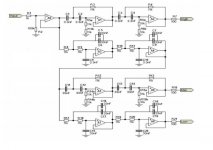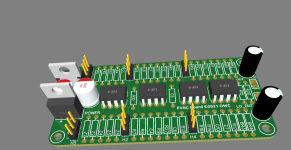Here is active XO 3 way 24db PCB from ebay
LR mono 3-way active filter by KMTech v1.4 PCB DIY BALANCED/UNBALANCED INPUT | eBay
Who is familiar with active XO design could easily to know how is this pcb schematic .
The question is . Is this PCB enough ? or should we extend this design .to something more reliable ?
LR mono 3-way active filter by KMTech v1.4 PCB DIY BALANCED/UNBALANCED INPUT | eBay
Who is familiar with active XO design could easily to know how is this pcb schematic .
The question is . Is this PCB enough ? or should we extend this design .to something more reliable ?
The board looks well designed, and he has multiple versions, for two, three channels. I didn't it see an schematic but it seems it's just the crossover. Normally a speaker has also baffle compensation and other filters. looks great for prototype and you can design an addon board if you need extra functionality. As reliably, looks good
He made the PCB like this . with no output buffer but as you mentioned we could add buffer if we want to .
Just for test I build today like this schema with no output buffer and it working good with no issue .
Just for test I build today like this schema with no output buffer and it working good with no issue .
Attachments
Last edited:
Unfortunately the vast majority of the active filters boards available work extremely poorly. (no offense)
With that I don't mean the quality, but the type of filters that are being used. (or the lack there of)
Even Elliots design doesn't make any sense at all if you're familiar/experienced with loudspeaker filter design.
For a good filter design one needs at least a shelving filter,
and two channels with at least 2nd or 3rd order LP/HP, param EQ/notch (per channel) as well as adjustable gain for one channel.
Currently I am busy developing such board.
It even has to option to route certain filter blocks differently.
By default it can be used for a 2-way system or 1-way system with more options, or can be used as a subwoofer filter.
Opamps can be picked by the user, adapter boards will also be available (for using SMD variations)
Multiple cards can be used as well.
At this moment I'm in the stage of writing a manual for this board
(which is taking far more time than doing the PCB design itself)
The idea came from another project/job I had to do, and decided to translate it to a little more DIY friendly project.
I don't know how much of a rush you have, because it will take a couple of weeks to finalize everything?
Here some pics as an impression, not final product yet.
Board size 80x40mm, will work on symmetrical power supply (regulators are on the PCB), and in the future there will also be an option available to use it on a single supply.
Spreadsheet will be available as well to easily calculate all values.
With that I don't mean the quality, but the type of filters that are being used. (or the lack there of)
Even Elliots design doesn't make any sense at all if you're familiar/experienced with loudspeaker filter design.
For a good filter design one needs at least a shelving filter,
and two channels with at least 2nd or 3rd order LP/HP, param EQ/notch (per channel) as well as adjustable gain for one channel.
Currently I am busy developing such board.
It even has to option to route certain filter blocks differently.
By default it can be used for a 2-way system or 1-way system with more options, or can be used as a subwoofer filter.
Opamps can be picked by the user, adapter boards will also be available (for using SMD variations)
Multiple cards can be used as well.
At this moment I'm in the stage of writing a manual for this board
(which is taking far more time than doing the PCB design itself)
The idea came from another project/job I had to do, and decided to translate it to a little more DIY friendly project.
I don't know how much of a rush you have, because it will take a couple of weeks to finalize everything?
Here some pics as an impression, not final product yet.
Board size 80x40mm, will work on symmetrical power supply (regulators are on the PCB), and in the future there will also be an option available to use it on a single supply.
Spreadsheet will be available as well to easily calculate all values.
Attachments
Last edited:
Good luck with your design .
I need 3 way crossover , with 4rd order filters (24db) . because the drivers I am using need a strong cut .
I need 3 way crossover , with 4rd order filters (24db) . because the drivers I am using need a strong cut .
Good luck with your design .
I need 3 way crossover , with 4rd order filters (24db) . because the drivers I am using need a strong cut .
4th order is also possible.
Good luck with your design .
I need 3 way crossover , with 4rd order filters (24db) . because the drivers I am using need a strong cut .
Have you considered DSP solutions?
All of the appropriate non-generic curve generation needed for system design is easily done in the DSP realm.
Dave.
To do active XO with opamp I have learned .and totally satisfied . it is a big improvement over passive XO .
About DSP XO , I have to dedicate some time to learn how to work with it .
About DSP XO , I have to dedicate some time to learn how to work with it .
No buffers needed as shown, Op Amp outputs are very low impedance by themselves.There is 'IN' buffer stage . but without 'OUT' buffer stage . Is it necessary OUT buffer stage ?
There's been quite a few DIY active crossover board projects here on DIYaudio. (A number of group buys as well.)To do active XO with op-amp I have learned .and totally satisfied . it is a big improvement over passive XO .
About DSP XO , I have to dedicate some time to learn how to work with it .
The problem with these (as mentioned earlier) is the topology doesn't always support your real-world project.
You might design a board with a shelving filter in Leg A and a notch filter in Leg B, (or whatever setup you need.) But then another speaker project comes along which needs a different scheme and your board won't support it. So, you have to design another board. 🙂
Or, you might design a "universal" board with all sorts of function in every leg so you have all the bases covered, but then you find yourself not needing 80% of the capability. 🙂
DSP, inherently, eliminates all these issues.......and adds myriad other capabilities as icing on the cake.
Dave.
That's a pretty BOLD statement, given Mr. Elliott's pedigree as one of the most astute DIY Audio designers we have. Do you have something to back this up?Unfortunately the vast majority of the active filters boards available work extremely poorly...... Even Elliots design doesn't make any sense at all if you're familiar/experienced with loudspeaker filter design.
> You might design a board with a shelving filter in Leg A and a notch filter in Leg B, (or whatever setup you need.)
> But then another speaker project comes along which needs a different scheme and your board won't support it. So, you have to design another board.
The solution is a modular approach :
https://www.diyaudio.com/forums/ana...ve-crossover-filter-solution.html#post5591077
Patrick
> But then another speaker project comes along which needs a different scheme and your board won't support it. So, you have to design another board.
The solution is a modular approach :
https://www.diyaudio.com/forums/ana...ve-crossover-filter-solution.html#post5591077
Patrick
As to DSP crossover, this was my experience :
John Curl's Blowtorch preamplifier part II
John Curl's Blowtorch preamplifier part II
Patrick
John Curl's Blowtorch preamplifier part II
John Curl's Blowtorch preamplifier part II
Patrick
I know Elliot, I have read his website for over a decade.That's a pretty BOLD statement, given Mr. Elliott's pedigree as one of the most astute DIY Audio designers we have. Do you have something to back this up?
Wonderful stuff, always fun and nice to read, absolute love his website!
I often even refer to his website!
But that doesn't mean it is the holy grail?
Hell, he even says that himself!
There is nothing bold about this statement.
Just look at an average filter that is needed and see if you can fit it in that filter board.
I personally don't really understand the whole offensive mood?
Don't really appreciate it to be honest.
I have been professionally working on and designing these active boards for over a decade by now. Last few years we changed everything to DSP yes, but before it was all active analog designs (for close to 30 years by now if I am not mistaken)
So I think I know a thing or two when I see such boards, just saying.
At least spell Rod's name right---it's E--L--L--I--O--T--T.
You still did not explain what about the design of his active crossover project:
Project 125
that "doesn't make any sense at all if you're familiar/experienced with loudspeaker filter design."
I think it's a quite elegant design, and fits the bill exactly.
You still did not explain what about the design of his active crossover project:
Project 125
that "doesn't make any sense at all if you're familiar/experienced with loudspeaker filter design."
I think it's a quite elegant design, and fits the bill exactly.
Yes I did on the previous page.
Next, I would recommend spending a little time on reading basic filter design.
Happy reading and have a nice day!
Bless!
ps.
Sorry, for the typo, they happen on keyboards.
Next, I would recommend spending a little time on reading basic filter design.
Happy reading and have a nice day!
Bless!
ps.
Sorry, for the typo, they happen on keyboards.
Suggest you publish a few of your own designs, before trying to get points by attacking one of the few serious, practical and no nonsense resources on the Web.
Personally I find it despicable, but hey, maybe it´s "normal" in your close group of acquaintances.
Adding the usual BS disclaimers
Have a nice day!
Bless!
Personally I find it despicable, but hey, maybe it´s "normal" in your close group of acquaintances.
Adding the usual BS disclaimers
Have a nice day!
Bless!
- Home
- Source & Line
- Analog Line Level
- active crossover PCB



